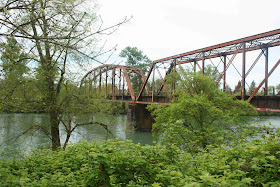Completion of the Willamette River Bridge between Eugene and
Springfield has been accomplished.
The gap is closed!
First train over the Willamette River Bridge! SP X7474 East crosses the river toward
Eugene.
The previous post (http://espeecascades.blogspot.com/2013/11/bridging-gap-willamette-river-bridges-1.html)
discussed the steel bridge sections (two Walthers single track through
trusses and a Micro Engineering deck plate girder) and the concrete pier
fabrication. Completing the job
required a ballasted deck pile trestle for the Springfield approach. I built a trestle bent jig using SP
CS1600 plans found in the Steam Age Equipment Company publication of Southern
Pacific Lines Common Standard Plans, Volume 1. This matches well to my photos taken at Springfield in April,
2013.
Trestle bents built using SP Common Standard plans.
Springfield pile trestle approach, April, 2013.
My model trestle was fabricated using Evergreen styrene
strip and a bit of V-groove siding for the ballast deck. N-scale cork roadbed continues the
model ballast form from the “land” side.
Model ballasted deck trestle trial fit.
Completed pile trestle approach with track loosely placed.
With all elements of the bridge fabricated and installable,
I decided to try painting the Willamette River. This was my first artistic venture using acrylic
paints. It took a couple of tries,
but the I finally got the desired effect of sky and river bank tree colors
reflected in the “water.” While I was
at it, I experimented with some backdrop painting, continuing the river onto
the nearby backdrop. The top photo
of this blog post shows the result.
My attempts at weathering the bridge and pier pieces took several
attempts using acrylics, Bragdon weathering powders and a final overspray with
the base colors.
A quick wiring job for the now-complete Eugene West Main detection
block completed the job. The
bridges and bridge track are lightly affixed with Dap 230 adhesive caulk. This will allow me to remove these
pieces for further scenery work.
Eventually, the two bridge track sections will need feeder wires, but
that can be done only when the installation is deemed complete and
permanent. For now, I’ll have to
accept power fed through the rail joiners.
With the Willamette River gap closed at last, I can run from
one end of the current mainline to the other—RR-West Oakridge to the RR-East
end of the Eugene depot trackage. The elusive goal of beginning “beta test” operations
on the current railroad just drew much closer.
Willamette River and bridge, April, 2013.
Note that the actual Eugene truss bridge span is a long
curved-chord truss while the Springfield truss span is a pin-connected
truss. I did not have space for
both bridges, so I elected to do what a railroad engineer would do—use two
standard bridges of the same design.
That led to the Walthers single track through truss which has the right “heft”
needed for a heavy mainline.






No comments:
Post a Comment